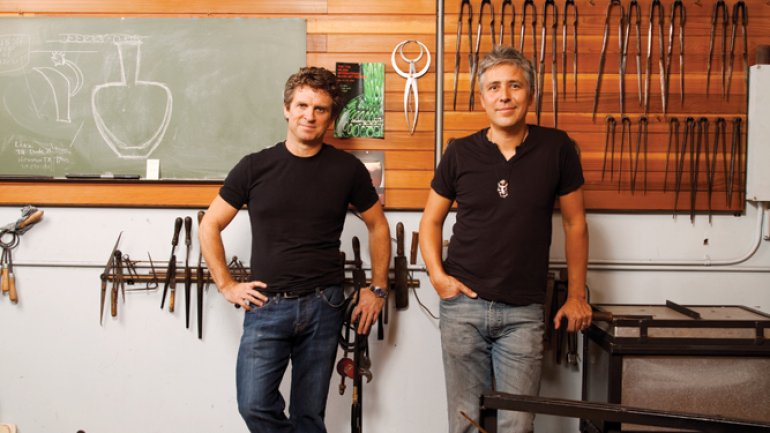Good Chemistry
Good Chemistry
Longtime pals Dante Marioni and Preston Singletary blend their divergent styles in a new body of work.
Preston Singletary remembers when that new kid showed up at his high school in Seattle back in 1979, the one who’d just moved from Oakland.
“He was quite a character,” recalls Singletary, then 15. “He had kind of a California vibe, this hip lingo. A very charismatic person.” Singletary would see him riding his bike around the neighborhood, and they would exchange waves. Finally they struck up a friendship.
The kid’s name was Dante Marioni, and he lived in a loftlike building (once the telephone company) that his dad, glass artist Paul Marioni, had converted to a residential workspace. At 15, Dante had just begun blowing glass himself and worked after school at a local studio, the Glass Eye. He got some of his pals jobs there, too, including Singletary. Soon they were all part of the lively community of glass artists that converged around nearby Pilchuck Glass School and turned Seattle into today’s capital of glass art.
Marioni and Singletary have traveled the glass path ever since, diverging but periodically meeting up again along the way. After high school, Marioni went straight into glassmaking and quickly earned an international reputation for his sophisticated, classical vessels and technical mastery. Singletary focused at first on a music career, working in glass studios by day and playing in rock bands at night, before deciding in 1995 to “fall back on my art” and make glass full time. A descendant of the Alaskan native Tlingit tribe, he began exploring that heritage in his work, reinterpreting traditional symbols and imagery in a contemporary, personal way, a direction that has brought him creative satisfaction as well as critical acclaim.
Now both seasoned artists in their late 40s, Marioni and Singletary are still close friends and live less than a mile from each other in the Seattle area. Throughout the 1980s and early ’90s, they worked side by side on glassblowing teams countless times. (At one point, Singletary was Marioni’s assistant.) But they never collaborated artistically, other than making what Marioni calls “goofy goblets” during the holidays, just for fun. As of 2011, it had been close to 20 years since they had worked together at all. “Once you have kids, everything changes,” Marioni observes; the two mostly saw each other at their sons’ Little League games.
So when Leroy Garcia, who represents both artists at his Blue Rain Gallery in Santa Fe and in Scottsdale, Arizona, invited them to create a shared body of work for the first time, they jumped at the challenge.
“It seemed like it would be an organic process, nothing too forced,” Marioni says. “We both come from similar enough places – in fact, the exact-same place when it comes to our glassblowing culture – that it was a no-brainer to figure out something we could do.” Plus, he adds, “it was a great excuse to go hang out with Pres.”
The resulting 20 basket-like forms, shown by Blue Rain in November at SOFA Chicago in “Primitive-Elegant,” blend two strong visions. The signature bold silhouettes and intricate canework patterns of the vessels are recognizably Marioni, yet are beautifully complemented by Singletary’s distinctive carved and sandblasted surface designs and sculpted elements – wolves, a whale, a tree, lightning, rain, and other beguiling images from nature, inspired by the indigenous art of the Pacific Northwest.
Like their distinct personalities – Marioni is high-energy, Singletary’s laid-back – their artistic styles and strengths meshed easily. Their most in-tense “negotiations” were about color, says Marioni, known for vivid primaries while Singletary favors earth tones. (The finished pieces have both.)
“It was very playful and a lot of fun. We have an easy way of working together, really natural and relaxing,” Singletary says of the collaboration, which both are eager to try again, maybe in a more sculptural, abstract vein. “The spirit of it was essentially the same as when we were teenagers,” says Marioni.“We got together in the studio and made stuff, like we always did. Only this time, we had a mission.”
Watch our video interview with the glass duo. Joyce Lovelace is American Craft’s contributing editor.

